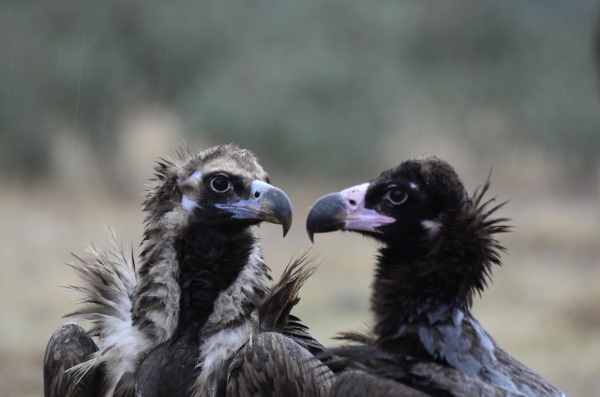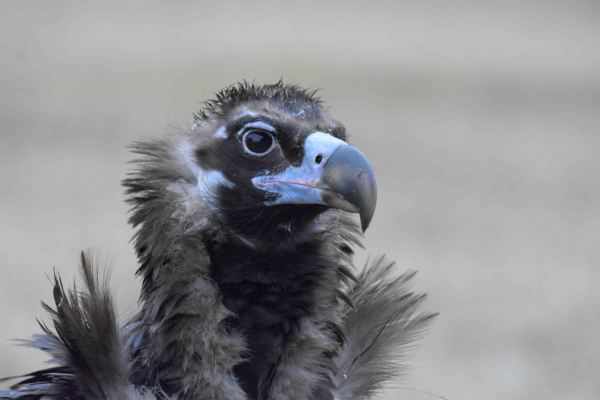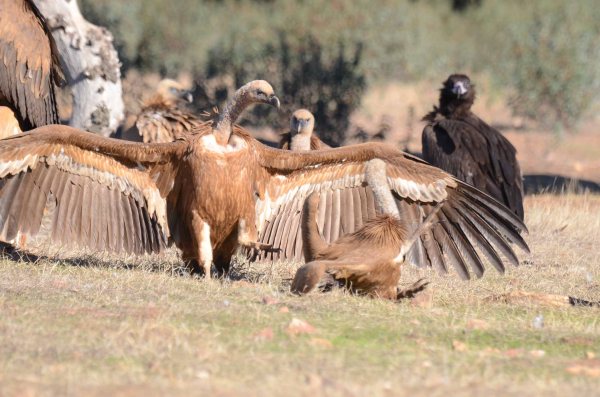Last year in Extremadura I was a guest of Helios Dalmau of Photo Raptor at his company’s dedicated vulture-watching hide in the Sierra de San Pedro. It was one of the wildlife highlights of last year.
Vultures in flight have long been renowned for their aerial grace, but perhaps more overlooked is the powerful impact of these birds on the ground. Part of the thrill is the sheer proximity of so many big volatile creatures, which can suddenly turn a feeding ground into a seething force-field of avian mass and muscle.

The maelstrom of heaving bodies is accompanied by a comparably unstructured cacophony of hisses, squeals and yikkering notes that are hardly euphonious, but for any observer they carry enormous emotional impact. Vultures in such feeding frenzies also demonstrate behaviour that is highly theatrical but, perhaps more unexpectedly, is enormously beautiful and full of humour. I would place the spectacle among the finest in all European ornithology.
A British birder who has never seen it can probably get a sense of the impact if they imagined a big flock of starlings. Think of all that fizz and intensity and those stabbing, bickering birds, but increase the size of each one by a factor of 100. The larger Gyps and Aegypius vultures are well known to exhibit a structured pattern of activity when assembled at such feeding sites. Despite the aura of chaos, vultures will wait their turn if a food source permits access to only limited numbers. Older and larger birds invariably get first turn but it is thought that digestive enzymes trigger aggression impelling younger, less-experienced birds to force their way to the front. The individuals that have fed well then concede ground and so feeding opportunities are rotated among the full assembly.

Griffon Vultures deploy a stylised threat posture when they sally forward in these situations. The very long neck is extended in a way that emphasises the bird’s reptilian ancestry. As the formidable meat-cleaving bill snakes ahead of its owner, so the enormous wings are often unfurled to full span and held at 90 degrees to the body, so that the bird advances on the broadest front. Or the wings, like the head and neck, are driven forward as part of a three-pronged assault. This heraldic-looking creature then processes in a slow, mincing goose-step that is one part controlled aggression, one part fabulous comedy.

An indisputable attraction of vulture restaurants in southern Spain is the opportunity to observe Cinereous Vultures in good numbers. At Sierra de San Pedro there were several dozens and it is hard to overstate the impact of this glorious bird at close quarters. Mature Cinereous Vultures stand over a metre tall and possess an enormously deep bill with a long dagger-like nail that is equipped to carve open the hide of fresh carcasses.

In adults the basal gape and sere are mauve-blue, but in immatures it is chewing-gum pink (see the pic above this one). At all ages the species possesses on the chest sides, front and back, a series of spiky neck quills that rise and fall as a perpetual barometer of their owner’s changing mood. In older birds the neck itself is often bare and the chest hackles paler and more luxuriant, making the effect of this ‘courtier’s ruff’ even more impressive.
In all interactions that we observed Cinereous Vultures appeared to be dominant over the more numerous Griffon Vultures .
The way in which the former species displaces any rival at a food source involves two characteristic manoeuvres. One entails an individual vigorously leaping forward, shovelling its huge yellowish feet foremost, followed by two-and-a-half metres of stiff flight feather in a formidable dark arc of aggression. The bird literally bulldozes opponents out of its path.

Another displacement technique that has more finesse – and is comparable to the Griffon Vulture’s goose-stepping advance – is even more captivating. In this the wings are drooped and pressed back so that bird acquires a broad-shouldered, flat-backed posture. The head is lowered, the scapulars stick upright and the tail is raised and fanned giving the bird a curiously turkey-like profile (you can see something of it in this Youtube footage I posted here https://www.youtube.com/watch?v=8kc40xISr7Q). The vulture then proceeds with an exaggerated foot fall that pitches it from side-to-side in an awkward but muscular swagger. All at once the bird looks ancient, magisterial and very funny.
Here it is (next two pics) if you cannot for any reason access Youtube. But I recommend you see the three pieces I posted because they really convey the joy of these birds.


A striking element of all the interactions is that the birds seem super-charged with aggression. Altercations between pairs or groups flare up constantly and vultures going full throttle at opponents will occasionally fall over with their wings stretched flat to the ground like feathered rugs (the two pics below capture this).


For all the drama, however, there appears to be little meaningful violence. In short, vulture aggression is mainly for show.
Vulture restaurants do far more than provide arresting theatre for human observers. The three larger European species have enjoyed a revival of fortunes partly because of SFSs. Bearded Vultures have roughly trebled in France and Spain to 164 pairs. Spanish Cinereous Vultures have also gone from 250 to 2,068 pairs and today the single Extremaduran range of Sierra de San Pedro holds more breeding pairs (300) than all Spain in the 1970s. This success has inspired the French to their own reintroduction projects and there are now 24 pairs north of the Pyrenees. It is the revival of Western Europe’s Griffon Vultures, however, that offers the most impressive figures. As recently as 1999, Forsman in The Raptors of Europe and the Middle East proposed a Spanish figure of c7,500-8,000 pairs with a total number of individuals of c23,000-24,500. Just 20 years later the breeding population for Spain is 30,000 pairs and, if one uses the same ratio of pairs to total individuals as cited by Forsman, then the country may hold c88,000 birds.
Aside from their positive effects on the birds themselves, I think these vulture-feeding sites, with their unique opportunities to see such large creatures at close quarters, are good for people too. They help us to realise that vultures are truly magnificent.

margaret21
/ August 23, 2018The highlight of a trip to la Rioja three years ago was definitely the omnipresence of the griffon vultures commanding the skies above us. We didn’t get the opportunity to see them at closer quarters. You’ve whetted my appetite!
Mark Cocker
/ August 23, 2018thanks Margaret, yes vultures are fabulous aren’t they but even better after a bottle or two of Rioja and in Spain it is always at the perfect temperature – both for vulture thermals and all that Rioja flavour 🙂
margaret21
/ August 23, 2018🙂
Jeremy Dagley
/ August 23, 2018A vivid encapsulation of the vulture’s world. Really enjoyed reading it and hope to get out there soon.
Mark Cocker
/ August 23, 2018thanks Jez hugely appreciated, well i really hope you see it but see it from one of the hides. You would be entranced i know.